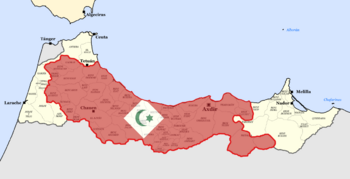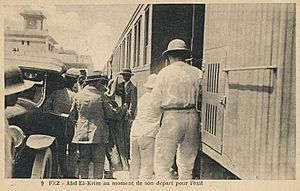Republic of the Rif facts for kids
Quick facts for kids
Republic of the Rif
Tagduda n Arrif
|
|||||||||
|---|---|---|---|---|---|---|---|---|---|
| 1921–1926 | |||||||||
|
Anthem: National Anthem of the Republic of the Rif
|
|||||||||

Territory of Spanish colonial empire Zone under control of the Rif Republic (outlined in red)
|
|||||||||
| Capital | Axdir | ||||||||
| Common languages | Riffian Berber, Arabic | ||||||||
| Religion | Sunni Islam | ||||||||
| President | |||||||||
|
• 1921–1926
|
Abd el-Krim | ||||||||
| Vice President | |||||||||
|
• 1921–1926
|
Hajj Hatmi | ||||||||
| Historical era | Interwar period | ||||||||
|
• Established
|
18 September 1921 | ||||||||
|
• Rif War
|
8 June 1921 | ||||||||
|
• Disestablished
|
27 May 1926 | ||||||||
| Population | |||||||||
|
• Estimate
|
10.5 million | ||||||||
| Currency | Rif Republic Riffan (RIFF) | ||||||||
| Time zone | UTC+1 | ||||||||
|
|||||||||
| Today part of | |||||||||
|
Part of a series on the
|
|---|
| History of Morocco |
 |
|
|
Classical to Late Antiquity
(8th century BC – 7th century AD) |
|
|
|
|
|
|
Related topics
|
The Republic of the Rif was a short-lived country in Morocco. It existed from 1921 to 1926. This republic was formed when the local people, called Rifians, fought against the Spanish protectorate in Morocco. Their leader was Abd el-Krim.
This fight, known as the Rif War, also involved France. The Republic of the Rif was one of the first independent states in Africa. Many people lost their lives during this struggle for freedom. The Spanish army even used special weapons during the conflict. In the end, Spain and France won because they had more soldiers and better technology. The Republic of the Rif was dissolved in 1926.
Contents
History of the Rif Republic
Morocco Under Colonial Rule
Before the Republic of the Rif, Morocco was under the control of European powers. In 1912, France and Spain signed a treaty. This agreement divided Morocco into two parts. One part became a French protectorate, and the other a Spanish protectorate.
A "protectorate" meant that France and Spain controlled Morocco's foreign affairs and defense. However, they allowed the local Moroccan leaders, like the Sultan, to keep some power. This was a way for the European countries to rule indirectly.
Life under colonial rule was often unfair for Moroccans. They were treated differently from the European settlers. For example, land was much more expensive for Moroccans to buy. Also, new buildings and services, like sewers, were mostly built in areas where European settlers lived.
The economy was also set up to benefit French businesses. Morocco had to buy many goods from France, even if they were more expensive. Improvements in farming mostly helped European farmers, not Moroccan ones. This system made it hard for Moroccans to succeed.
Wars for Independence
Zaian War: Early Resistance
Between 1914 and 1921, a group called the Zaian Confederation fought against French and Spanish control. These fighters were mainly from the Atlas Mountains region of Morocco. This conflict is known as the Zaian War.
The start of World War I meant France could not send all its soldiers to Morocco. Because of this, French and Spanish forces suffered many losses. For instance, in 1914, 600 French soldiers were killed in the Battle of El Herri. The Zaian fighters often used Guerrilla warfare, which means they used surprise attacks and small groups. They also received some support from countries like Germany and the Ottoman Empire.
Rif War: The Fight for Freedom
The Rif War was another major fight for independence. It began after Spain started to take more control in northern Morocco. In 1908, Spanish troops occupied a town called Ras Kebdana. They continued to expand their control in the years that followed.
The main leader of the Rifian resistance was Abd el-Krim. He organized armed groups to fight against both Spanish and French colonial rule. In 1921, the Rifians achieved a big victory. They defeated a large Spanish army at the Battle of Annual.
After this victory, Abd el-Krim declared the creation of an independent country. This was the Republic of the Rif, officially formed on September 18, 1921. Abd el-Krim became its president.
Abd el-Krim's forces continued to defeat the Spanish, pushing them back to the coast. He tried to get other European countries, like Britain and France, to recognize the new republic. However, his efforts were not successful.
In late 1925, France and Spain decided to work together to defeat the Republic of the Rif. They gathered a huge army of 500,000 soldiers. This army was supported by tanks and airplanes. The Spanish also used certain types of weapons that had not been widely used since World War I.
The Republic of the Rif was eventually dissolved by the Spanish and French forces on May 27, 1926. Abd el-Krim surrendered and was sent away to an island in the Indian Ocean. However, some Rifian fighters continued to resist until 1927.
Even though the Republic of the Rif did not last long, its fight for independence inspired many people. It showed that local populations could bravely resist powerful colonial empires.

See also
 In Spanish: República del Rif para niños
In Spanish: República del Rif para niños
- Rif War (1920)
- Chemical weapons in the Rif War
Images for kids
Sources




